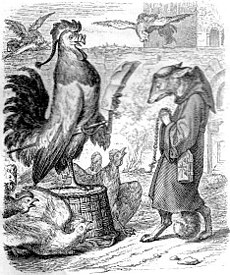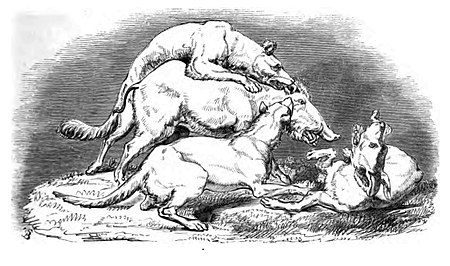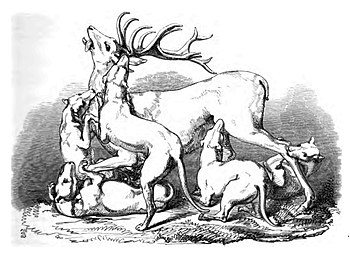Hermann Ploucquet
Hermann Ploucquet (born April 12, 1816 in Stuttgart , † February 16, 1878 ibid) was taxidermist at the Royal Natural History Cabinet in Stuttgart and maintained a "Zoological Museum" with a huge collection of prepared animals and groups of animals.
His naturalistic representation of prepared animals stood in contrast to the dry, scientific preparation style of his time. He developed dioramas with groups of animals in their natural habitat and humorous scenes with humanized animal representations. The exhibition of his groups of animals at the first world exhibition in London in 1851 was a great success and gave Ploucquet a groundbreaking influence on the development of taxidermy.
life and work
origin
Hermann Ploucquet was born on April 12, 1816 in Stuttgart as the youngest child of the fairer Karl Ploucquet (1778–1855) and his wife (1788–1855). His father came from an old Huguenot family from which a number of famous members emerged. The mother was a daughter of the ducal Württemberg agricultural inspector Johann Eberhard Etzel (1745–1792) and a sister of the senior building officer Eberhard von Etzel , the builder of the Neue Weinsteige in Stuttgart.
youth
The Ploucquet family lived in "poor circumstances". To help his relatives, Hermann's uncle Eberhard von Etzel took the family into his house at Langen Strasse 61. He particularly took care of his talented young nephew's education. He attended secondary school and received drawing and art lessons from his uncle. Hermann was more attached to sport and nature than to intellectual subjects. In self-tuition he learned how to prepare animals and was able to help support the family by selling the preparations.
When he had to choose a career with his confirmation, he would have preferred to become a painter or sculptor, but had to start an apprenticeship as a gardener with the court gardener Bosch to earn a living. Being outdoors and being in contact with nature suited his temperament. At the same time, he continued to deal with the preparation of animals. After completing his apprenticeship, the 17-year-old found a job as an assistant at the Royal Natural History Cabinet in Stuttgart due to his excellent knowledge and skills in animal taxidermy .
Museum taxidermist
In the natural history cabinet, Ploucquet was called in as an assistant to belching and stuffing animals, but as a non-scientific employee he had little chance of advancement. It was not until 1847 that he was appointed taxidermist. The State Museum for Natural History in Stuttgart owes Ploucquet countless specimens, including 212 of the museum's 2,711 bird specimens.
In his spare time, Ploucquet carried out private preparation assignments. Ploucquet achieved mastery in his craft and developed into an artist in his field, "he knew like no other how to reproduce the animals in all their peculiarities so realistically that the viewer was not aware of the usual museum whiff of death" . His naturalistic representation stood in contrast to the dry, scientific preparation style of his time.
Dioramas
He prepared birds in nests or on branches, the dead domestic animals of his fellow human beings or the prey of hunters. Soon he also created dioramas, communities of animals, which he depicted in different ages, in both sexes and in summer and winter clothes in a natural environment and in dramatic hunting scenes.
Inspired by the animal caricatures by Wilhelm von Kaulbach and Grandville , he also put together humorous depictions of humanized animals that made the viewer laugh and think and especially delighted the children. Through his exhibitions in Leipzig in 1850 , London in 1851 and Munich in 1854, Ploucquet attracted international attention, which gave him a pioneering influence on the development of taxidermy.
Zoological Museum
Hermann Ploucquet gave up his position at the Royal Natural History Cabinet in 1858 in order to be able to devote himself entirely to his own business, but also because “he had become more and more spoiled for work; because the head of the cabinet, Christian Ferdinand Friedrich Krauss, did not appreciate the thirst for activity and the enterprising spirit of his taxidermists, let alone appreciate it or even use it for his own institution; he was and remained a narrow-minded, if not narrow-minded, sometimes quite intolerant superior ”.
In order to cope with his numerous assignments and his own projects, he acquired a property at Kronenstrasse 11. To support him, he hired employees who he taught in preparation. His only, unmarried sister Pauline, who ran the household for the brother, who was also unmarried, since the death of his parents in 1855, was a talented dress artist and took care of the dressing of the animal dolls. Ploucquet set up his “Zoological Museum” with its huge collection of stuffed animals and groups of animals in a large garden parlor (30 × 10 meters).
Due to the expansion of the station area, he had to give up his property in 1864 and temporarily store his collection in construction huts of the Polytechnic until he was able to move into his newly built property at Herdweg 56 in 1869. Here he set up his museum again, but due to the great distance from the city center at that time it did not bring the desired success. Ploucquet sold his collection, which was shown for two years in the Berg Mineralbad before it was sold to the Crystal Palace in Sydenham near London. There the collection was destroyed in a fire in 1936.
Retirement
After the death of his sister Pauline around 1869, a related couple took care of Ploucquet. The proceeds from his collections allowed him a financially carefree retirement. The occupational contact with arsenic , which was used to preserve the animal specimens, led to progressive blindness at Ploucquet, so that he could no longer work as a taxidermist. As a trained gardener, he found his pleasure in building his gardens and running a small farm. He died at the age of 61 on February 16, 1878 in Stuttgart and was buried in the Prague cemetery.
Exhibitions
Through his participation in exhibitions in the 1850s, Ploucquet attracted international attention, which gave him a pioneering influence on the development of taxidermy. He exhibited his animal groups in 1850 at the industry exhibition in #Leipzig , in 1851 at the world exhibition in #London and in 1854 at the industry exhibition in Munich.
Leipzig
In 1850 Ploucquet took part in a national exhibition for the first time. His animal groups were very well received at the industrial exhibition in Leipzig:
- “The groups of animals at Ploucquet… are indeed excellent, and always have a great number of spectators before them. Not only that the individual animals are stuffed and placed with the greatest fidelity to nature, but the arrangement of the groups is just as attractive as it is ingenious. ... The two main groups shown are: a burrow, where the hustle and bustle of the young foxes is actually amusing, and then a chicken dog, standing in front of a crowd of partridges, a group that appears to have been copied down to the smallest detail of nature. "
His caricatures, for example "zealous duelists whose graves are buried by moles", aroused general amusement.
London
In 1851 Ploucquet took part with a large number of his animal groups in the first world exhibition in London, where he personally took care of the installation of his exhibits in the Crystal Palace . According to the catalog, the following exhibits were exhibited:
- “Groups of stuffed animals and birds. A deer hunt. A wild boar hunt. Groups and nests of different prey birds. Owls preying on hawks. Groups of different species of native birds with their young. "
Ploucquet's groups of animals were one of the crowd pullers at the exhibition and were constantly besieged by large and small visitors. The novel, lively presentation of dead, stuffed animals was admired, and the satirical depictions struck a chord with the English for bizarre humor. The response in the press was overwhelming. The photographer Antoine Claudet captured some of Ploucquet's arrangements on daguerreotypes , which Harrison William Weir used as a template for woodcuts and which were published together with frame stories under the title “The comical creatures from Wurtemberg”. The retelling of Goethe's Reineke Fuchs contained in the book , which was illustrated with six scenes of Ploucquet's groups of animals, made the hitherto unknown story popular in England.
The two following images show Hermann Ploucquet's showcase “The kittens at tea”. Left: Daguerreotype by Antoine Claudet, right: Woodcut by Harrison William Weir.
The two following images show Hermann Ploucquet's showcase “Reynard in the likeness of a hermit” (Reineke as a hermit). Left: Daguerreotype by Antoine Claudet, middle: woodcut by Harrison William Weir. The illustration on the right shows a woodcut based on a drawing by Wilhelm von Kaulbach from 1846, which Ploucquet used as a template.
The two following prints show two groups of large animals by Hermann Ploucquet.
Left: wild boar hunting, right: deer hunting.
literature
life and work
- Karl Dietrich Adam : From the 200 year history of the Stuttgart Natural History Museum. Stuttgart: State Museum for Natural History, 1991, page 5, 18-19, pdf .
- Karl Büchele: Stuttgart and its surroundings for locals and foreigners. Stuttgart 1858, 137-140, pdf .
- Hermann Ploucquet. A side piece to the Affenwerner. In: Eugen Dolmetsch: Pictures from Old Stuttgart. Retold and self-experience. Stuttgart 1930, pages 94-112.
- Hermann Ploucquet; Philipp Leopold Martin: Short instructions for collecting natural-historical, especially zoological objects, in revision with H. Ploucquet edited by L. Martin, taxidermists in Stuttgart. 1863. In: Journal für Ornithologie, Volume 11, 1863, Pages 144–153, pdf .
- Stuttgart address books, 1800–1880 , online .
- Friederike Woog; Holger Haag; Iris Heynen: The bird collection of the State Museum for Natural History Stuttgart (SMNS) - finds from Germany with a focus on Baden-Württemberg. In: Annual Issues of the Society for Natural History in Württemberg, Volume 159, 2003, Pages 207–263, pdf .
- Rachel Youdelman: Iconic Eccentricity: The Meaning of Victorian Novelty Taxidermy. In: PsyArt, Volume 21, 2017, Pages 38–68, pdf .
Exhibitions
- William G. FitzGerald: Side Shows III. In: The Strand Magazine. An Illustrated Monthly, Volume 13, 1876, January – June, pages 521–528, here: 523–525, pdf .
- A visit to the trade exhibition in Leipzig in April 1850: Special reprint of the preliminary report of the Leipziger Handels-Zeitung. Leipzig: Expedition of the Handelszeitung, 1850, pages 63–64, pdf .
- Catalog of the industrial exhibition in Leipzig. 1850. Leipzig, 1850, page 115, catalog number 1291, pdf .
- Great Exhibition of the works of industry of all nations, 1851. Official Descriptive and Illustrated Catalog. Volume 3: Foreign States. London: Spicer, 1851, pp. 1120-1121, pdf .
- Catalog of the general German industrial exhibition in Munich in 1854. Munich, 1854, page 226, catalog number 6758, pdf .
- Hermann Ploucquet: The comical creatures from Wurtemberg: including the story of Reynard the fox / with 20 illustrations, drawn from the stuffed animals contributed by Hermann Ploucquet of Stuttgart to the Great Exhibition. 2nd edition, London: Bogue, 1851, pdf .
- Routledge's Guide through the Great Exhibition: containing a description of every principal object of interest: with a plan, pointing out the easiest and most systematic way of examining the contents of the Crystal Palace by Great Exhibition. London: G. Routledge, 1851, pp. 136-137, pdf .
Web links
Footnotes
- ↑ Famous members of the Ploucquet family: Gottfried Ploucquet (1716–1790), professor of logic and metaphysics in Tübingen, Wilhelm Gottfried Ploucquet (1754–1814), professor of medicine in Tübingen, Christoph Friedrich Ploucquet (1781–1844), founder of a beautiful dyeing factory and cloth making in Heidenheim an der Brenz.
- ↑ #Dolmetsch 1930 , page 97-98.
- ↑ #Dolmetsch 1930 , page 98.
- ↑ #Dolmetsch 1930 , page 99.
- ↑ #Woog 2003 , page 215.
- ↑ # Adam 1991 , p. 19.
- ↑ #Dolmetsch 1930 , page 100-101.
- ↑ # Adam 1991 , p. 5.
- ↑ Among his students were the future zoo owner Wilhelm Tiedemann and the taxidermist Robert Banzer.
- ↑ # Büchele 1858 .
- ↑ #Stuttgart address books . - At that time, today's Herdweg 56 building had the address Herdweg 22.
- ↑ #Dolmetsch 1930 , page 111-112. - According to Dolmetsch, the grave was a "foundation grave" in Section H, Row VI.
- ↑ # Munich 1854 .
- ↑ #Leipzig 1850 , pages 63-64, #Leipzig 1850.2 .
- ↑ #Leipzig 1850 , page 63.
- ↑ #London 1851 .
- ↑ #Ploucquet 1851 .
| personal data | |
|---|---|
| SURNAME | Ploucquet, Hermann |
| BRIEF DESCRIPTION | German taxidermist |
| DATE OF BIRTH | April 12, 1816 |
| PLACE OF BIRTH | Stuttgart |
| DATE OF DEATH | February 16, 1878 |
| Place of death | Stuttgart |









